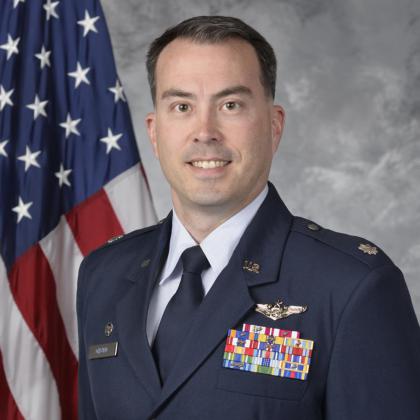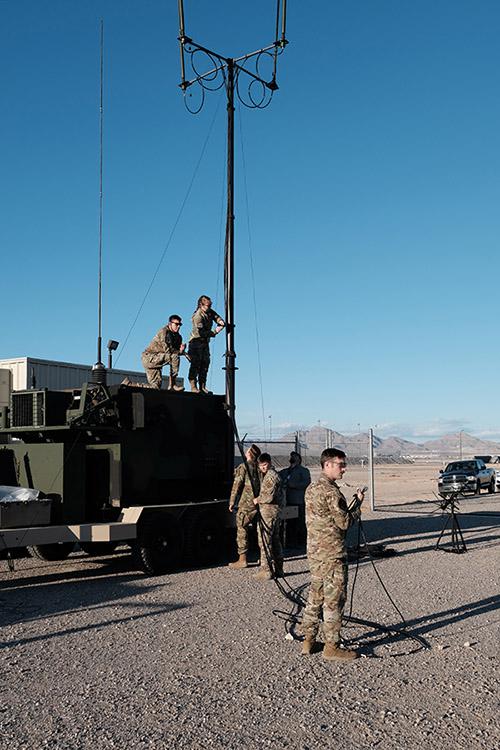Commercial Solutions Eyed for Advanced Battle System
The Department of the Air Force’s latest Industry Day propelled the service and private sector one step further in the quest to achieve an operationally optimized advanced battle management system (ABMS). The event at Nellis Air Force Base, Nevada, hosted on June 9 by the 805th Combat Training Squadron—also known as the Shadow Operations Center–Nellis (ShOC-N)—specifically examined dynamic targeting and kill-chain automation capabilities.
“We had over 100 business leaders attend the event with action officers from the ABMS Cross-Functional Team (ABMS CFT), Air Combat Command and the 505th Command and Control Wing briefing updates to industry at the ShOC-N,” said Lt. Col. John Ohlund, USAF, ShOC-N commander. “A key takeaway is continued engagement with industry is a must. From an operator standpoint, making sure industry is aware of the recent advancements, some of latest lessons learned, or where the “pain points” exist are important. This helps industry understand where the Air Force could use their support.”
The effort is part of the service’s larger mission to create a Department of the Air Force Battle Network and provide joint all-domain command and control (JADC2) to the greater military. The ShOC-N/805th, which was designated by the Joint Chiefs of Staff as the Air Force’s laboratory for JADC2, is one of four units in the 505th Command and Control Wing that is developing, testing, training and conducting exercises for Air Force command and control. Given its position as the JADC2 operational lab, the ShOC-N is a venue where industry, acquisition and operators can all come together to evolve concepts and tactics, techniques and procedures, the colonel asserted.
Building on the ShOC-N’s December 2022 capstone event, the June 9 Industry Day focused on solutions for manual and/or automated data facilitation, and distribution to intelligence, command and control, battle management fielded systems and new prototypes, according to a spokesperson from the 505th Command and Control Wing.
Industry representatives rotated through the experimentation at Nellis, exposing them to “a visceral and experience-based understanding of the pain points and challenges,” the spokesperson said. Airmen experimented with industry capabilities to increase the quality and speed of battle management decision-making. They used existing systems and prototypes integrated “to maximize data sharing, automation and timeline compression.” This is an area of importance for the Air Force. Working with data scientists and analytical teams, the ShOC-N’s goal is to evolve manual data collection into automated processes. “To answer operational utility and rapid acquisition decisions on a timeline our leaders need requires the ShOC-N and other labs to evolve into an automated and instrumented facilities,” Col. Ohlund said.
For the private sector, the event also brought to light the importance of interoperability. “Some may believe in a ‘one system to rule them all’ mindset, but industry is recognizing the value of making their data shareable,” he stated. “Systems that cannot share or exhibit difficulties integrating with others are fading.” The leaders are seeing some in industry focused on demonstrating interoperability, and the lab enables companies to come in and improve their data sharing, “working side-by-side on the same warfighter issues” with other companies and warfighters.
Naturally, integration is necessary across the legacy systems, although the level of integration hinges on how those systems were originally designed. Here, ShOC-N leaders are seeing companies motivated to modify their software to enable automated programming interfaces or similar features that improve data sharing, Col. Ohlund said. He also confirmed that the ShOC-N is seeing more and more machine automation with demonstrations of artificial intelligence (AI). There are several prototypes offering AI or AI-like solutions.
“AI is coming and there is still more work to be done,” he said. “And given that data is needed in large quantities to train algorithms…. the ShOC-N, the shadow part of our moniker, offers the ability to connect to various data sources in the background of events or exercises and vet those offerings.”
In addition, the June 9 event featured a briefing of the service’s Transformational Model methodology. To support future solicitation and ABMS-related acquisition efforts, the ABMS CFT is developing a series of systems engineering models, including the Transformational Model-Battle Management (TM-BM); the Transformational Model-Planning and the Transformational Model-Planning Command. These models will help Brig. Gen. Luke Cropsey, USAF, program executive officer, command, control, communications and battle management, and his team as they examine the operational functional requirements for the three decision domains of command and control: planning, command and battle management. The models are also helping discern between necessary human roles and automated computer roles. Col. Jonathan “Beep” Zall, USAF, from the ABMS CFT, has been leading the modeling effort over the last year and a half.
Col. Christopher Cannon, USAF, chief of ABMS Experimentation and Battle Lab, presented an update on the modeling effort to industry. “Col. Cannon’s brief on the transformational model for battle management was eye-opening for many,” Col. Ohlund stated.
“One of the valuable aspects of Col. Zall’s work is ensuring that the model remains unclassified. The ABMS CFT’s work with the other services, allies and partners is seeing buy-in. Col. Zall and team offer it up front. It’s just a model and not the DAF [Department of the Air Force] pushing the model. As for the separation of human and computer tasks, the model has the promise and detail to show those distinctions. It’ll be exciting when we can scale the TM-BM into future experiments.”
The TM-BM, which is the most developed model of the three, distills command and control and battle management down to the most fundamental steps and processes, allowing the Air Force to have a “very precise” picture of battle management by showing which functions can be automated by computers and which ones are necessary for humans to perform.
“What we assert, through the transformational model methodology, is that there are different domains of decision-making,” Col. Zall said. “To achieve JADC2 and decision advantage, where do you do that? What we assert is you do that in these decision domains, which are distinguishable from each other. A decision that a planner makes is distinguishable from a decision that a battle manager makes. That is distinguishable from a decision that a commander makes and is distinguishable from a decision that intelligence analysts make, and so on. And by understanding the differences between those decisions, we can effectively resource them all.”
In addition, the event—and the service more broadly—is also looking at specific tactics, techniques and procedures needed to use automation within command and control.
As a part of that effort, a group from the 805th is examining the human side of command and control and battle management and collected more data on human performance at the event.
“The way that the model addresses the human component is as the performer of these decision functions in a human-machine team,” Col. Zall said. “And that human-machine team might be a single human, a piece of paper and a pencil. It might be a supercomputer with a human just watching it with the veto button, just in case, or it might be my crew and an E-7. And absolutely at the core of this is taking into account the fact that humans and machines are a part of this system, but it is not ‘let’s add in humans after the fact,’ after we’ve designed the networks and the technology. No, they are baked in from the start.”

A key takeaway is continued engagement with industry is a must.

Col. Zall also emphasized that the TM-BM model is running continuously at Nellis. “Just about every time somebody is at Nellis, we drag them off the street, throw them into the experiment, and then say thank you and send them on their way, whether they were there for that or not,” he shared. “We’re building up data points.”
This constant experimentation environment at Nellis is shaping the Air Force’s ability to adroitly ask for future private sector solutions.
“We can crank up the experiment, plug in your solutions and see if the outcomes make battle management better or not,” Col. Zall noted. “Whereas before, we had no means of really effectively quantifying the requirements in the first place, much less verifying the performance of those systems. Now we can say, ‘Let’s look at this specific capability and measure it and do statistical analysis and see if your solution actually provides us a bump in capability that we wanted.’”
Having companies that are willing to come into the operational environment with their potential tools is crucial at this stage, Col. Zall continued. “By inviting industry into the ShOC-N, just as Chief [of the Air Force Charles Q.] Brown wanted this facility to be an opportunity for warfighters and technology to come together, it gives us a better path to better solutions overall, instead of getting so far along in the acquisitions process to where we’ve essentially boxed out possible solutions,” he said. “And with the way that we intend for it to help in terms of writing requirements for systems, now we can be specific about the performance of those systems.”
The ShOC-N is gearing up to host the next ABMS event, to be held December 4-8, 2023, at Nellis—and the leaders are encouraging industry to get involved. “The level of interest in our ShOC-N Capstone has only increased,” said Col. Ohlund. “It’s at a point where we need a framework to ensure the event’s prototypes and experiments are sequenced and aligned with the 505th Command and Control Wing, U.S. Air Force Warfare Center, Air Combat Command, C3BM PEO, and the Air Staff.”
To take possible JADC2 and Battle Network solutions to the next level, the December 2023 event is projected to require a secret clearance.
“So, if you or someone in your community is interested, I would recommend partnering with Ms. Deb Henley, [from the Wing’s public affairs office] to join us for the event.”
In the meantime, an open invitation to industry stands from the 805th. “The ShOC-N continues searching for industry partners developing technology that can be modified to meet mission needs and innovative constructs that will influence command and control systems, software development and experimentation in the future,” the 505th spokesperson said.






Comments